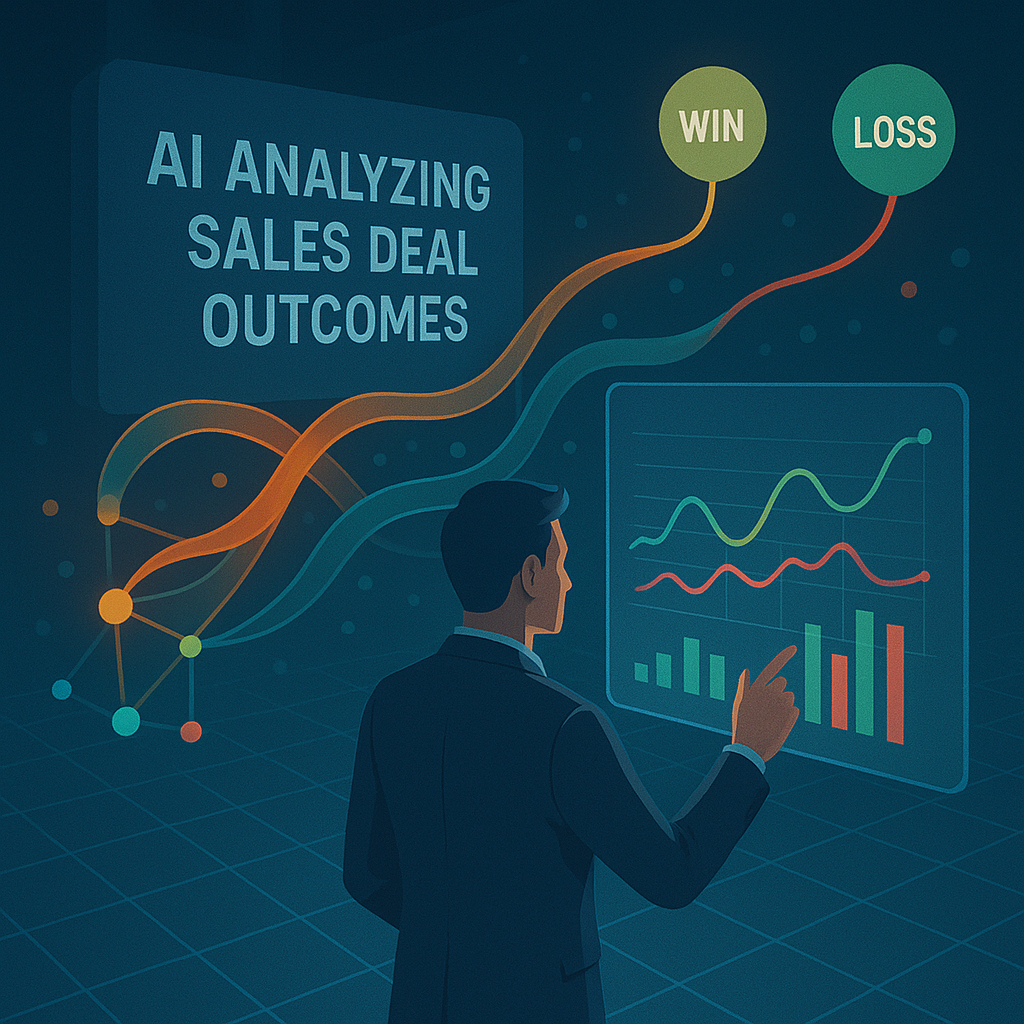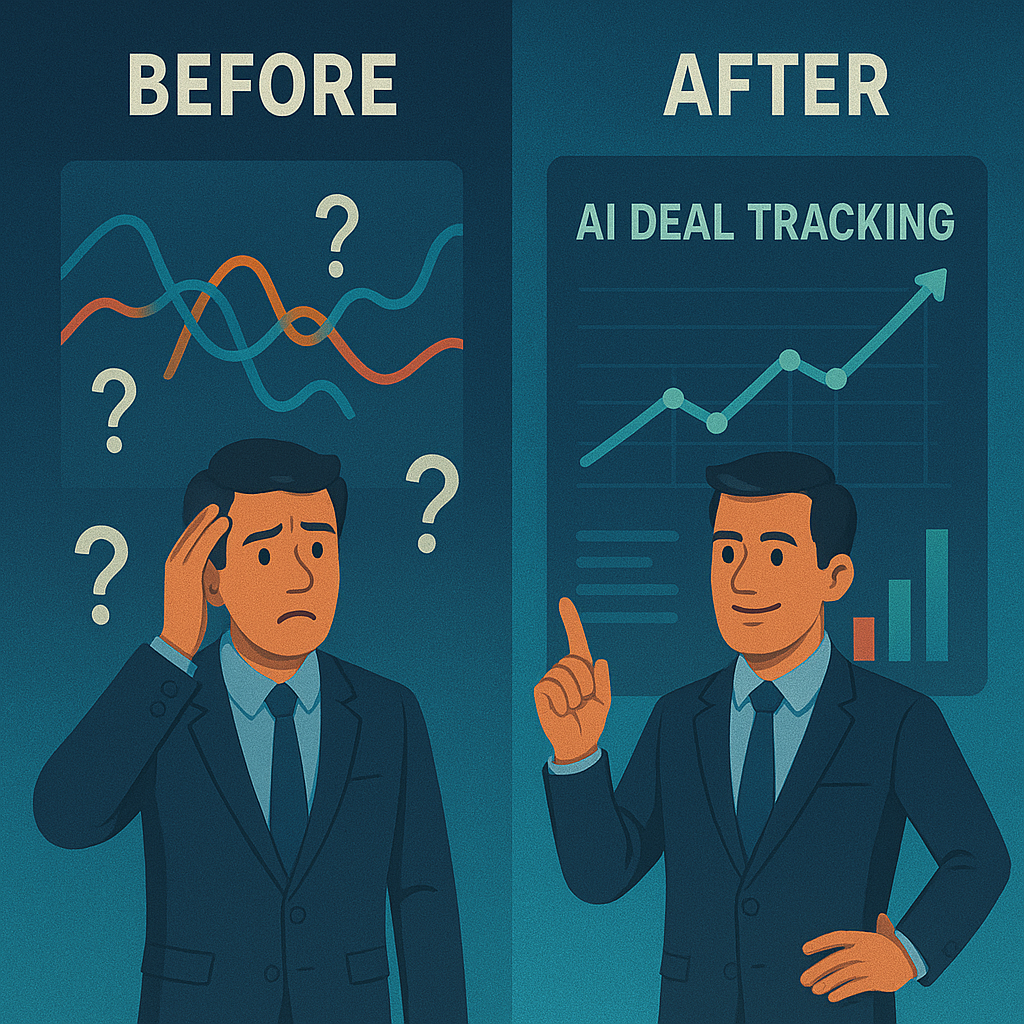Leverage Deal Outcome Tracking AI to Supercharge Sales Results
In today’s data-driven business landscape, understanding why your sales team wins or loses deals isn’t just helpful—it’s essential for sustainable growth. Yet many organizations still rely on subjective feedback or basic CRM data rather than diving deep into the patterns behind their deal outcomes. This is where deal outcome tracking AI steps in as a game-changer.
Sales leaders who harness automated win-loss analysis gain unprecedented visibility into the factors influencing their deals, empowering them to make strategic adjustments that drive results. In this article, we’ll explore how this technology works, the value it delivers, and practical steps for implementation.

Understanding Deal Outcome Tracking AI
Before diving into the transformative benefits, let’s establish a clear understanding of what deal outcome tracking AI actually is and how it functions in a modern sales organization.
What Is Deal Outcome Tracking AI?
Deal outcome tracking AI represents a sophisticated evolution of sales intelligence tools that automatically analyzes closed deals—both won and lost—to identify patterns and factors that influence outcomes. Unlike traditional CRM analytics that focus primarily on pipeline metrics and activity tracking, this AI-powered approach digs deeper into the why behind deal results.
At its core, deal outcome tracking AI comprises:
- Natural language processing (NLP) to analyze sales calls, emails, and customer interactions
- Machine learning algorithms that identify patterns across successful and unsuccessful deals
- Predictive analytics to forecast likely outcomes of active deals based on historical patterns
- Recommendation engines that suggest specific actions to improve win rates
The technology has evolved significantly from early rule-based systems to today’s sophisticated AI that continuously learns from each new closed deal, making its insights increasingly valuable over time. AI templates for sales analytics have made this technology more accessible and customizable for businesses of all sizes.
How Deal Outcome Tracking AI Works
The power of deal outcome tracking AI lies in its systematic approach to data collection and analysis:
- It gathers data from multiple sources, including CRM records, email communications, call transcripts, proposal documents, and contract details
- The AI applies machine learning algorithms to identify correlations between specific factors and deal outcomes
- Pattern recognition capabilities uncover trends that human analysts might miss, such as subtle language patterns in successful sales calls
- The system integrates with existing sales tools to deliver insights directly within the workflows your team already uses
For example, the AI might detect that deals closing in under 45 days share common characteristics: they typically involve a specific decision-maker role, include product demonstrations before the third meeting, and address pricing conversations directly in the second call.
The Business Value of Automated Win-Loss Analysis
Implementing deal outcome tracking AI delivers concrete, measurable value across multiple dimensions of sales performance. Let’s examine the quantifiable benefits and how the technology uncovers hidden patterns that drive improvement.
Quantifiable Benefits for Sales Organizations
Organizations implementing automated win-loss analysis typically see improvements across key performance indicators:
| Performance Metric | Typical Improvement | Contributing Factors |
|---|---|---|
| Win Rate | 15-30% increase | Better qualification, optimized messaging, improved objection handling |
| Average Deal Value | 10-25% increase | Earlier solution alignment, value-based selling insights |
| Sales Cycle Duration | 20-40% reduction | Streamlined processes, elimination of low-value activities |
| Forecast Accuracy | 30-50% improvement | Data-driven probability scoring, better risk identification |
Beyond these metrics, organizations often report significant improvements in sales team retention and satisfaction, as representatives gain clearer guidance on what actually works.
Uncovering Hidden Patterns in Sales Performance
The true power of deal outcome tracking AI lies in its ability to identify patterns that would otherwise remain invisible:
- Competitor strength mapping: Pinpointing exactly which competitive claims resonate with buyers and which competitors pose the greatest threat in specific segments
- Buyer behavior insights: Understanding how different stakeholders influence decisions across various deal types and industries
- Proposal effectiveness: Identifying which proposal elements, language choices, and pricing structures correlate with higher close rates
- Rep performance factors: Discovering the specific behaviors that distinguish top performers beyond just activity metrics
These insights enable sales leaders to move beyond gut feelings and anecdotal evidence to make truly data-driven decisions about sales strategy.

Implementing Closed Deal Analysis
Successfully implementing deal outcome tracking AI requires thoughtful planning around data collection and integration with existing processes.
Data Requirements and Collection
The effectiveness of your AI analysis depends heavily on the quality and completeness of your data. Focus on capturing:
- Deal attributes: Industry, company size, deal value, product mix, contract terms
- Stakeholder information: Titles, roles in decision process, engagement levels
- Timeline data: Sales cycle length, time between stages, response times
- Competitive factors: Competitors involved, displacement scenarios, competitive messaging encountered
- Interaction records: Call recordings, email exchanges, meeting notes (with appropriate consent)
Data quality considerations include ensuring consistency in how information is recorded, minimizing missing fields, and validating information accuracy. Privacy and compliance concerns must be addressed upfront, with clear policies on data usage and appropriate anonymization where necessary.
When integrating historical data, plan for a cleaning and normalization phase to ensure your AI has a reliable foundation for learning patterns. AI-powered data processing can help streamline this process and ensure your data is ready for analysis.
Integration with Existing Sales Processes
For maximum adoption and impact, your deal outcome tracking AI should feel like a natural extension of existing workflows:
- CRM integration: Ensure bidirectional data flow between your CRM and the AI system, with insights surfaced directly within familiar interfaces
- Training approach: Develop role-specific training that focuses on how each team member can apply AI insights to their specific responsibilities
- Change management: Address potential resistance by emphasizing how the AI supports rather than replaces human judgment
- Phased implementation: Consider starting with a specific sales team or region to demonstrate value before broader rollout
Creating internal champions who can showcase early wins will accelerate adoption across the organization.
Leveraging Post-Sale Performance AI
The value of deal outcome tracking extends well beyond the initial sale, offering powerful insights that connect sales approaches to long-term customer outcomes.
Connecting Sales Outcomes to Customer Success
By analyzing the relationship between how deals are sold and subsequent customer experiences, deal outcome tracking AI enables organizations to optimize for customer lifetime value, not just short-term revenue.
The connection between sales process and customer success isn’t just theoretical—it’s measurable. Organizations using deal outcome tracking AI report identifying specific sales behaviors that correlate with 30-40% higher customer retention rates and 25% more expansion revenue.
Key capabilities in this area include:
- Correlating specific sales promises and expectations with customer satisfaction metrics
- Predicting which newly closed customers have the highest potential for upsell or cross-sell
- Identifying early churn risk based on patterns in how the deal was sold
- Optimizing initial deal structures to maximize customer lifetime value
Creating Feedback Loops for Continuous Improvement
The most sophisticated implementations establish automated feedback loops that ensure insights translate into continuous performance improvements:
- Automated insight delivery: Pushing relevant findings to team members when they need them, such as before similar deals
- Actionable recommendations: Converting analysis into specific, contextual guidance for sales activities
- Performance dashboards: Creating visibility into how insights are impacting key metrics over time
- Success benchmarking: Establishing clear metrics to evaluate the impact of AI-driven changes
These feedback mechanisms transform deal outcome tracking from a passive analysis tool into an active driver of ongoing performance improvement.
Case Studies: Transformative Results with Deal Analysis AI
To illustrate the real-world impact of deal outcome tracking AI, let’s examine two organizations that have successfully implemented this technology.
Enterprise SaaS Company Success Story
A rapidly growing enterprise software company faced challenges with inconsistent sales performance and unpredictable forecasting. Despite having a robust CRM implementation, they struggled to understand why similar deals often had radically different outcomes.
After implementing deal outcome tracking AI:
- The system identified that deals involving IT security stakeholders before the third meeting closed 62% more frequently
- Analysis revealed that competitive wins shared a pattern of addressing specific integration concerns early in the sales process
- The AI discovered that proposal language emphasizing implementation timelines resonated more strongly than cost-saving messaging
By applying these insights, the company achieved:
- 27% improvement in overall win rates within six months
- 41% more accurate sales forecasting
- 22% reduction in average sales cycle length
- ROI of 547% over 18 months
Manufacturing Firm’s Revenue Transformation
A mid-sized industrial manufacturing company with a complex, multi-step sales process was struggling with lengthy sales cycles and inconsistent margins. Their technical sales process involved numerous stakeholders and competing priorities.
Their approach included developing a custom AI model trained specifically on their unique sales environment. Key findings included:
- Deals where technical specifications were finalized before budget discussions closed at 3.2x the rate of reverse-ordered deals
- Engaging plant managers within the first 30 days correlated with 45% higher close rates
- Competitor displacement was most successful when focusing on operational reliability rather than initial cost
These insights led to:
- 18% year-over-year revenue growth in a market growing at just 3%
- 35% increase in average deal size
- Significant margin improvement through better qualification and pricing optimization
Future Trends in AI-Driven Sales Intelligence
As deal outcome tracking AI continues to mature, several emerging trends are worth monitoring for organizations looking to maintain a competitive edge.
Predictive Deal Scoring and Recommendation
Next-generation systems are moving beyond historical analysis to provide forward-looking guidance:
- AI-driven opportunity scoring that continuously updates based on the latest interactions and market conditions
- Personalized sales tactics recommendations tailored to specific deal contexts and buyer personas
- Automated competitive intelligence that alerts teams to changing competitive positioning in real-time
- Real-time coaching suggestions delivered during customer interactions
These capabilities enable sales teams to be more proactive and precise in their approach to each opportunity.
Conversational Intelligence Integration
The integration of conversational intelligence with deal outcome tracking represents perhaps the most transformative emerging capability:
- Call and meeting analysis that automatically identifies successful conversation patterns
- Sentiment analysis that detects subtle shifts in buyer engagement and enthusiasm
- Objection pattern detection that categorizes and tracks how different types of concerns impact deal progression
- Automated follow-up suggestions based on conversation content and buyer responses
Organizations implementing these advanced capabilities are seeing even greater performance improvements as they fine-tune not just their overall sales process but individual customer conversations.
Conclusion: Transforming Sales Through AI-Powered Deal Intelligence
Deal outcome tracking AI represents a fundamental shift in how organizations approach sales improvement—moving from opinion-based coaching to data-driven optimization. By systematically analyzing what works and what doesn’t across your closed deals, you gain unprecedented ability to replicate success and eliminate failure patterns.
The organizations seeing the greatest impact are those that approach implementation as a strategic initiative rather than just another tool deployment. With proper data foundations, thoughtful integration, and commitment to acting on the insights generated, deal outcome tracking AI can transform not just sales results but the entire customer journey.
As you consider how automated win-loss analysis might benefit your organization, start by assessing your current data quality and identifying high-impact areas where greater insight could drive immediate results. The journey toward AI-enhanced sales intelligence begins with a commitment to learning from every deal—win or lose.
